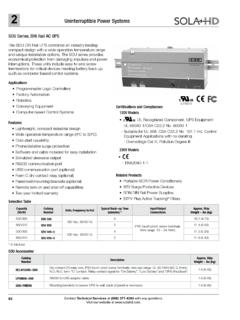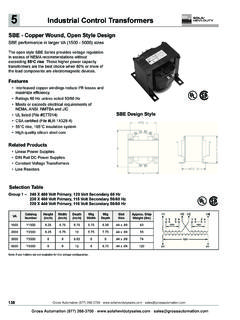Transcription of Operating Characteristics of the CVS & MCR Series
1 Contact Technical Services at (800) 377-4384 with any our website at 431 Power Protection and ConditioningOperating Characteristics of the CVS & MCR SeriesRegulationSolaHD s CVS power conditioners will hold output voltages to or less with input variations as great as 15% (115V 15% or 120 V +10%/-20%). Units operated at less than rated load will maintain approximately 1% regulation over a wider input line voltage variation. Output meets NEMA voltage specifications even when input voltage drops to 65% of nominal. The output versus input voltage relationship for a typical CVS is show in Figure A.
2 Figure A: Load VariationNote: MCR line regulations: 3% for 60 Hz; 5% for 50 Hz. The typical performances shown in Figure B indicate that most of the residual changes take place near the lower (95 V) and upper (130 V) ends of the input range. It is possible to improve output regulation if line variations remain within a restricted range near the center of the nameplate range (for example, 100-120 V). Figure B: Line RegulationExcept as noted, all Characteristics of Sola/HD s CVS products also apply to the MCR Series . Normally, the output voltage will rise as the load is decreased.
3 Typical percentages for changes in resistive load from full to zero load as shown CharacteristicsSolaHD power conditioners include a resonant circuit that is energized whether or not it is serving load. The input current at no load or light load may run 50% or more of the full primary current. As a result, the temperature of the unit may rise to substantially full-load level, even at light or no load. Input power factor will average 90-100% at full load, but may drop to about 75% at half load and 25% at no load. In any case, the current is always leading.
4 The input no load watts are about of the VA rating. FrequencyOutput voltage varies linearly with a change of frequency of the input voltage. This change is about of the output voltage for each 1% change in input frequency and in the same direction as the frequency FactorSolaHD power conditioners regulate any power factor load. Output voltage is a function of load current and load power factor (see Figure C). If lower voltage under lagging power factor is objectionable, correction may be made with capaci-tors at the load. Median value of output voltage will vary from the nameplate rating if the load has a power factor other than that for which the transformer was designed.
5 Load regulation will also be relatively greater as the inductive load power factor is decreased (see Figure C). However, the resulting median values of output voltage will be regulated against supply line changes at any reasonable load or load power factor. CVS Conditioner Rating - VAIncrease in Output Voltage due to Load Removal303%60 & 1202%250 & over1%Contact Technical Services at (800) 377-4384 with any our website at 441 Power Protection and ConditioningMotor LoadsBecause of the fast response time of the solahd circuit, any current-limiting characteristic must be taken into account for transient overloads such as motor starting and solenoid operation.
6 In general, the solahd constant voltage regulator must have a capacity nearly equal to the maximum demand made on it, even for an instant. To determine the power rating of the regulator, peak motor-starting current or solenoid inrush current should be measured or power factor correcting capacitors should be used to reduce the starting VA of the load. Response TimeAn important advantage of solahd s ferroresonant trans-former is its fast response time compared with other types of AC regulators. Transient changes in supply voltage are usually corrected within 1 cycles or less; the output voltage will not fluctuate more than a few percent, even during this interval.
7 Figure D: Overload PerformanceFigure C: Power FactorEfficiencyThe copper magnet wire and lamination material used in solahd ferroresonant products are selected to achieve efficiencies of 90% or higher. Whether or not an external load is being served, current will be drawn from the line whenever the primary is energized, since the capacitor remains con-nected in the circuit. Overload and Short CircuitsWhen the load is increased beyond the regulator s rated value, a point is reached where the output voltage suddenly collapses and will not regain its normal value until the load is partially released.
8 Under direct short circuit, the load current is limited to approximately 150-200% of the rated full load value and the input watts to less than 10% of normal. A constant voltage regulator will protect both itself and its load against damage from excessive fault currents. Fusing of load currents may not be necessary. The actual value of short-circuit current varies with the specific design and rating. Units may be operated indefinitely at short-circuit. This characteristic protects the unit itself as well as the load and load circuit being served. Typical overload performance is shown in Figure D.
9 Operating Characteristics of the CVS & MCR SeriesContact Technical Services at (800) 377-4384 with any our website at 451 Power Protection and ConditioningTemperatureSolaHD s ferroresonant power conditioners are very stable with respect to temperature. The change in output voltage is only C. Units are factory adjusted to +2%/-0% of nominal, with full load and nominal input voltage. This adjustment to the high side of nominal is to compensate for the natural temperature drift of about 1% that takes place during initial turn-on or warm-up. When the unit warms up to Operating temperature, the voltage typically falls about 1%.
10 At a stable Operating temperature, the output voltage will change slightly with varying ambient temperatures. This shift is equal to approximately 1% for each 40 C of temperature change. The normal maximum temperature rise of a solahd power conditioner may fall anywhere in the range of 40 C to 110 C depending on the type and rating. The nominal design ambient range is between -20 C and +50 C (-20 C to +40 C for 70 - 1000 VA, 60 Hz portable models). External Magnetic FieldIn almost all applications, this effect may be exclusive solahd wide outside leg construction reduces stray magnetic fields to a practical minimum.











